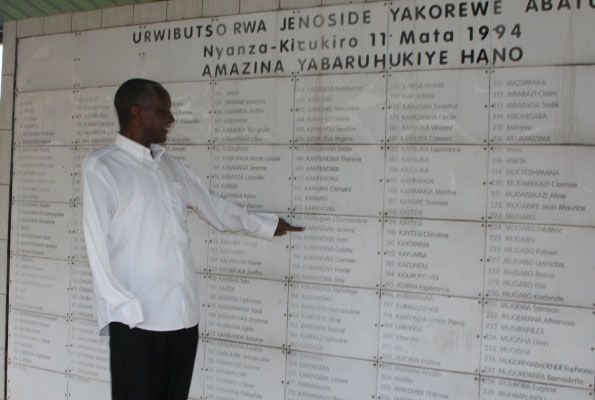
Although thousands were hacked to death, there were those who survived miraculously, considering the circumstances. In the fourth part of the series, Faustin Mugabe talks to two survivors about their narrow escape.
My name is Venuste Karasira. I am 62, and an old boy of Kampala High School and Kitante Hill School in Kampala. I was born in south-central Rwanda, but my family later shifted to a place near Kigali. I came to Uganda for the Ordinary and Advanced levels education at the two famous schools in Uganda then, respectively, between 1973 and 1979. I went back to Kigali to attend to my ill and aging father and never returned to Kampala. Because of the “circumstances”, I never returned to Uganda to further my education. In 1980, I started working as a clearing and forwarding agent in Kigali. But the business went up in flames in 1994.
I was living in Nyanza, in Kicukiro District on the outskirts of Kigali, and it is where I still stay. It is one of the affluent suburbs near Kigali. Nyanza is somewhat attached to Kigali just as Zzana and Busabala villages on Entebbe Road are connected to Kampala although they are in Wakiso.
Although it had been not easy for the Tutsi living in Rwanda at that time, after October 1, 1990, when the Rwanda Patriotic Front (RPF) attacked Rwanda, things changed for the worse. The Tutsi had a rough time. People would meet you in broad daylight and taunt you. They would say: “You Tutsi, you will see.” We really had rough time in those days. Many times, I tried to secure a Hutu identity card for my safety, in vain. It was also very risky to acquire a Hutu identity card when you were not one.
Then, President Habyarimana died in that airplane crash. On the night of April 6, 1994, we heard heavy gun shots around the city. Although gun shots were common in Kigali and its environs, this was sporadic and went on through the night. People tuned to Radio Rwanda for information. When it was announced that Habyarimana had died in a plane crash at the airport, it terrified us.
I remember my wife telling me, “Now, we will die. We will be finished. They will finish us all.” Immediately, Radio Television Libre de Mille Collines (RTLM) started broadcasting messages to kill all the Tutsi. The killing started there and then. We were terribly scared.
The following day, April 7, we did not go out. We remained inside our homes as the government forces and the Interahamwe militias had run amok killing every Tutsi and destroying their property.
Seeking refuge
On the morning of April 8, my wife, our son, two daughters and I, miraculously ran from our home and we took refuge at a nearby technical school – known as the Official Technical School of Kicukiro (ETO). There was a camp for the United Nations Assistance Mission in Rwanda (UNAMIR) forces from Belgium.
When we entered, I was shocked by the extent of injuries people had sustained from the Interahamwe attacks. Others had been hacked to death as they struggled to enter the camp — others died inside.
April is a rainy season in Rwanda, but in April 1994, it rained more than we had seen before. It was raining almost every hour. I suggested that all men except the sick and elderly let the classrooms be occupied by women and children.
You can imagine a situation where between 2,000 and 3,000 people were crammed in an enclosure. We dug pit-latrines as the sanitary situation threatened to blow up into a catastrophe.
We did all this as the Interahamwe watched us over the fence. They also taunted us as the UNAMIR forces from Belgium watched on. They really tormented and taunted us for being Tutsi, and for allegedly killing Habyarimana… like hyenas stalking their prey, the Interahamwe watched the old and sick as they were ready to kill at the first opportunity. When the insults became unbearable, we asked UNAMIR to contact the Rwanda Patriotic Front (RPF), to come to our rescue since they [UNAMIR] could not help us. They refused.
On April 10, we heard that the UNAMIR forces were going to withdraw from Rwanda and return home. We were terrified to the marrow. Again, we asked them to contact RPF to come and protect us since when they were going.
But they refused. On the morning of April 11, the Belgians started to pack their luggage in preparation for evacuation. We begged them not to abandon us to the Interahamwe but they did not heed to our pleas. They didn’t care at all regardless of the inevitable which was obvious upon their departure. They said that the gendarmerie (Rwanda police) would come to protect us.
When they were about to set off, we told some boys to lie beneath the wheels of the trucks, to prevent them from abandoning us to our enemies who looked thrilled. It didn’t work. The Belgian soldiers shot in the air and the terrified boys dispersed in disarray to the joy of the Interahamwe.
Belgium had withdrawn its peacekeeping forces, following the killing of 10 of its soldiers by the government forces and Interahamwe on April 7, a day after Habyarimana died. Like a lion leaving a carcass for the salivating hyena to munch, the Belgian forces left the Tutsi and moderate Hutus.
No sooner had they left than the Gendarme and Interahamwe rushed inside. That was in the afternoon. And the slaughter started.
Taken to the slaughter
They did not want some members of the international community who were residing around Sonatube, another affluent village nearby, to see them killing us, so they took us from ETO, to about a kilometre away to slaughter us.
The place was Nyanza. Now remembered as a genocide site, it was at that time a refuse dump site. So, the genocidaire leaders said: “Take these refuse to their fellow refuse and dump them there.”
When we asked why we were being taken to an unknown destination, they said they were taking us to another place to give us protection. As we walked to the death site, we were continuously taunted. Many people were already psychologically “dead” though they were physically walking their last journey on earth. Finally, we reached Nyanza. We were told to sit down. It was a bushy place.
At around 5pm, the Interahamwe asked for the Hutu to produce their cards as evidence. A Tutsi man stood up and moved forward. Then one Interahamwe man approached him. He asked: “Are you a Hutu?” The man said, “Yes.” Within a blink of an eye, he stabbed him in the neck and the sword penetrated the belly before the man fell to the ground, dead.
A few minutes later, the Interahamwe commander ordered them to start the job. Every tool that could kill was used to finish us off. First, they threw grenades, then started shooting. Afterwards, amidst wailing and groaning, machetes, swords, knives and axes were used to hack those still alive. I was shot in the right arm and in the leg.
Rescued
I don’t know how I survived. But, I know that out of about 3,000 less than 100 of us are still alive. The killing went on until the morning of April 12 at around 5am, when the RPF arrived. They were going to Rebero hill to attack the military barracks, and this saved us. They killed the Interahamwe who were looking for those still alive.
The RPF took us to hospital; my right arm was amputated. My wife and our three children survived with injuries. Another son who was elsewhere also survived.
We have now reconciled. We forgave them. What else could we do? They [genocidaires] came back from prison and we are living together. And that is reconciliation. When people say, “Never Again”, I wish it could be practical.
Remember, it was first said in Europe after the World War II, and it again happened here. Where were those who said never again after WWII? Is it because Rwanda has no minerals that Europeans always go for, that genocide happened here?
SOURCE: monitor.co.ug




